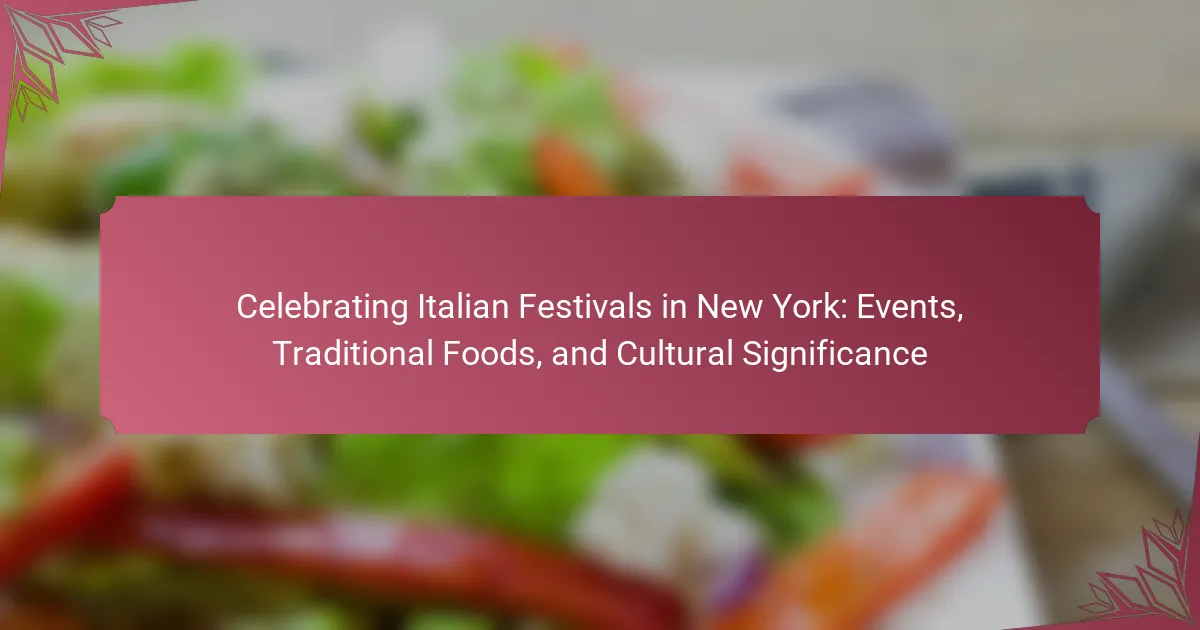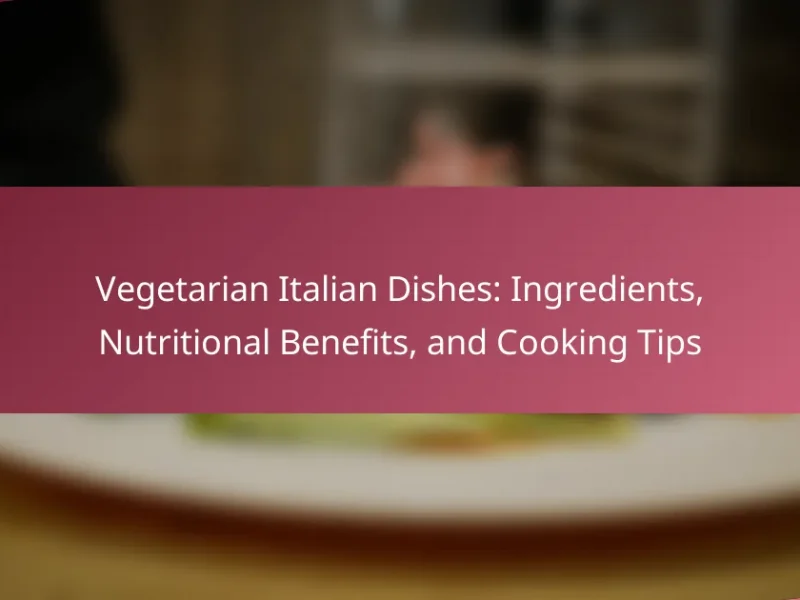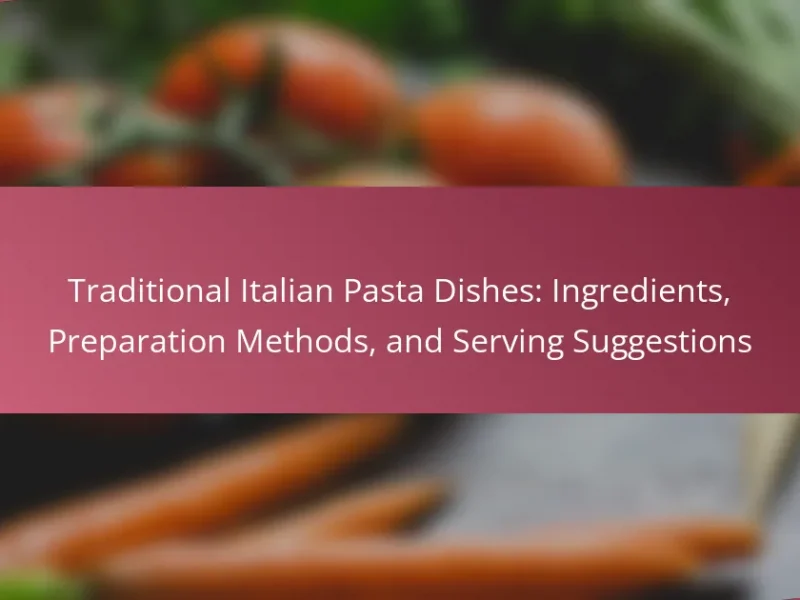Italian festivals in New York, such as the Feast of San Gennaro, Italian Heritage and Culture Month, and the Feast of Our Lady of Mount Carmel, celebrate the rich cultural heritage of the Italian-American community. These events feature traditional foods like pasta, pizza, cannoli, arancini, and sausage and peppers, highlighting the culinary legacy of Italy. The festivals serve as important cultural gatherings, fostering community identity and promoting cultural exchange. They attract diverse audiences and reinforce historical connections to early 20th-century Italian immigrants, ensuring the continued presence of Italian culture in New York.
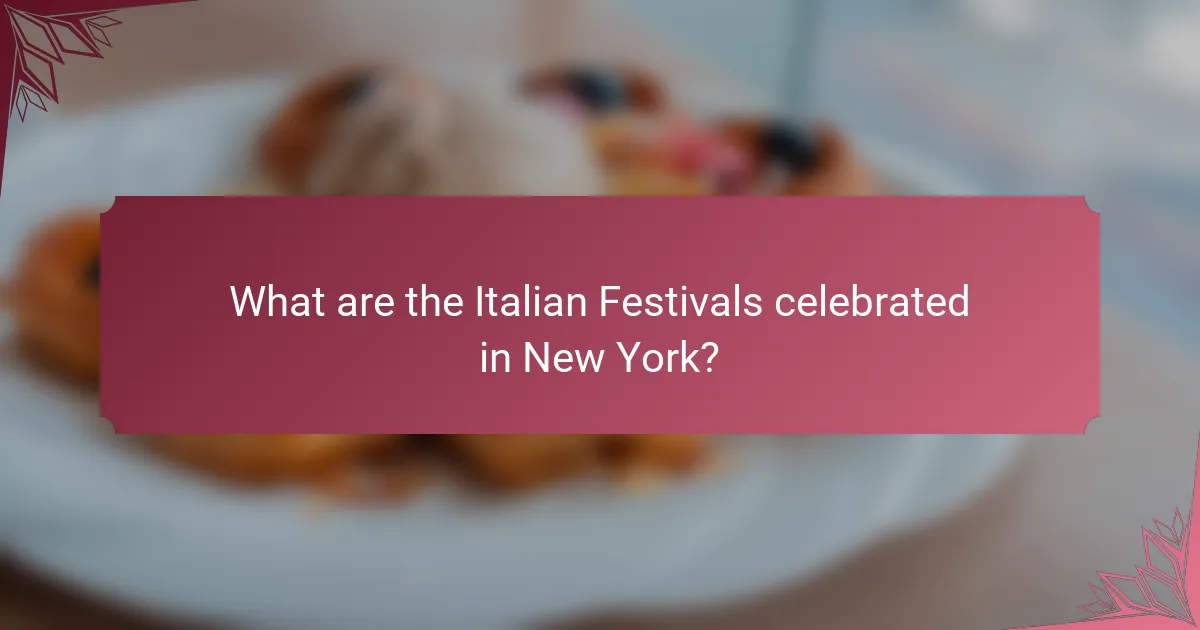
What are the Italian Festivals celebrated in New York?
The Italian festivals celebrated in New York include the Feast of San Gennaro, the Italian Heritage and Culture Month, and the Feast of Our Lady of Mount Carmel. The Feast of San Gennaro occurs annually in Little Italy and lasts for 11 days. It features parades, religious processions, and food vendors. The Italian Heritage and Culture Month is celebrated throughout October with various events highlighting Italian-American contributions. The Feast of Our Lady of Mount Carmel, held in Williamsburg, includes a religious procession and traditional Italian food. These festivals celebrate Italian culture and community in New York.
How do these festivals reflect Italian culture?
Italian festivals reflect Italian culture through their celebration of traditions, food, and community. These events showcase regional customs and historical significance. Festivals often include religious processions, highlighting Italy’s deep-rooted Catholic heritage. Traditional foods served during these festivals, such as pasta and pastries, emphasize Italy’s culinary diversity. Music and dance are integral, showcasing folk traditions and regional variations. The communal atmosphere fosters social bonds and a sense of belonging among attendees. Overall, these festivals serve as a vibrant expression of Italian identity and cultural pride.
What historical events led to the establishment of these festivals?
Italian festivals in New York were established due to significant immigration waves. The first major wave occurred in the late 19th century. This wave brought a large number of Italian immigrants seeking better opportunities. They settled in neighborhoods like Little Italy. The festivals served to celebrate their cultural heritage and traditions. Events like the Feast of San Gennaro began in 1926. These festivals provided a sense of community and belonging. They also helped preserve Italian customs and fostered cultural pride among immigrants.
Which communities are most involved in these celebrations?
The communities most involved in these celebrations are primarily Italian-Americans. They actively participate in various Italian festivals throughout New York. These events often showcase traditional foods, music, and cultural practices. Additionally, other cultural communities may join in the celebrations, fostering a sense of unity. The involvement of Italian-Americans is significant, as they represent a large portion of New York’s population. Historical events, such as the Feast of San Gennaro, highlight this community’s deep-rooted traditions. These festivals often attract diverse attendees, enhancing cultural exchange.
What are the key events associated with Italian festivals in New York?
Key events associated with Italian festivals in New York include the Feast of San Gennaro, the Italian American Day Parade, and the Feast of Our Lady of Mount Carmel. The Feast of San Gennaro takes place annually in Little Italy, celebrating Italian culture with food, music, and religious processions. The Italian American Day Parade occurs in October, showcasing Italian heritage with floats, music, and performances. The Feast of Our Lady of Mount Carmel features a religious procession and traditional Italian food, highlighting community and faith. Each event attracts thousands of attendees, emphasizing the significance of Italian-American culture in New York.
What are the most popular festivals and their dates?
The most popular Italian festivals in New York include the Feast of San Gennaro, held from September 15 to September 25. Another significant event is the Italian American Heritage Festival, typically celebrated in October. The Columbus Day Parade occurs on the second Monday of October. Additionally, the Feast of Our Lady of Mount Carmel is celebrated in July. Each festival showcases Italian culture through food, music, and traditions, attracting large crowds annually.
How do these events vary across different neighborhoods?
Italian festivals in New York vary significantly across different neighborhoods. Each neighborhood showcases unique cultural traditions and community involvement. For instance, the Feast of San Gennaro in Little Italy is renowned for its vibrant street fair and religious processions. In contrast, the Italian-American community in Bensonhurst focuses on family-oriented events with traditional foods and music. Festivals in Astoria often blend Italian heritage with Greek influences, reflecting the area’s diverse population. Additionally, neighborhoods like the Bronx celebrate with parades that highlight Italian-American contributions to the city. These variations are influenced by the demographic makeup and historical context of each neighborhood.
Why is it important to celebrate Italian festivals in New York?
Celebrating Italian festivals in New York is important for cultural preservation and community bonding. These festivals showcase Italian heritage, traditions, and customs. They offer a platform for the Italian-American community to express their identity. Events such as the Feast of San Gennaro attract thousands, promoting cultural pride. Traditional foods featured at these festivals highlight culinary diversity. Celebrating these events fosters understanding among different cultures. It strengthens community ties and encourages participation from diverse groups. Festivals also contribute to the local economy through tourism and small business support.
What role do these festivals play in cultural preservation?
Festivals play a crucial role in cultural preservation. They serve as platforms for sharing and celebrating traditional practices. These events help maintain language, music, and art forms unique to Italian culture. For instance, traditional foods are showcased, allowing recipes and culinary techniques to be passed down. Festivals also foster community bonding among participants, strengthening cultural identity. Moreover, they attract younger generations, encouraging them to engage with their heritage. Research indicates that cultural festivals can enhance community cohesion and pride. This reinforces the idea that such events are vital for sustaining cultural legacies.
How do they contribute to community bonding and identity?
Italian festivals in New York contribute to community bonding and identity by fostering cultural pride and unity. These events bring together individuals who share similar heritage, strengthening social connections. Participants engage in traditional activities, such as music, dance, and food, which reinforce shared cultural values. Festivals often feature communal meals, allowing families and friends to gather and celebrate together. This shared experience enhances a sense of belonging among attendees. Furthermore, these events attract diverse audiences, promoting cultural exchange and understanding. Research shows that community festivals can improve social cohesion and enhance residents’ sense of place (Cultural Participation and Community Cohesion, Arts Council England, 2016). Thus, Italian festivals serve as vital platforms for reinforcing community identity and fostering interpersonal relationships.
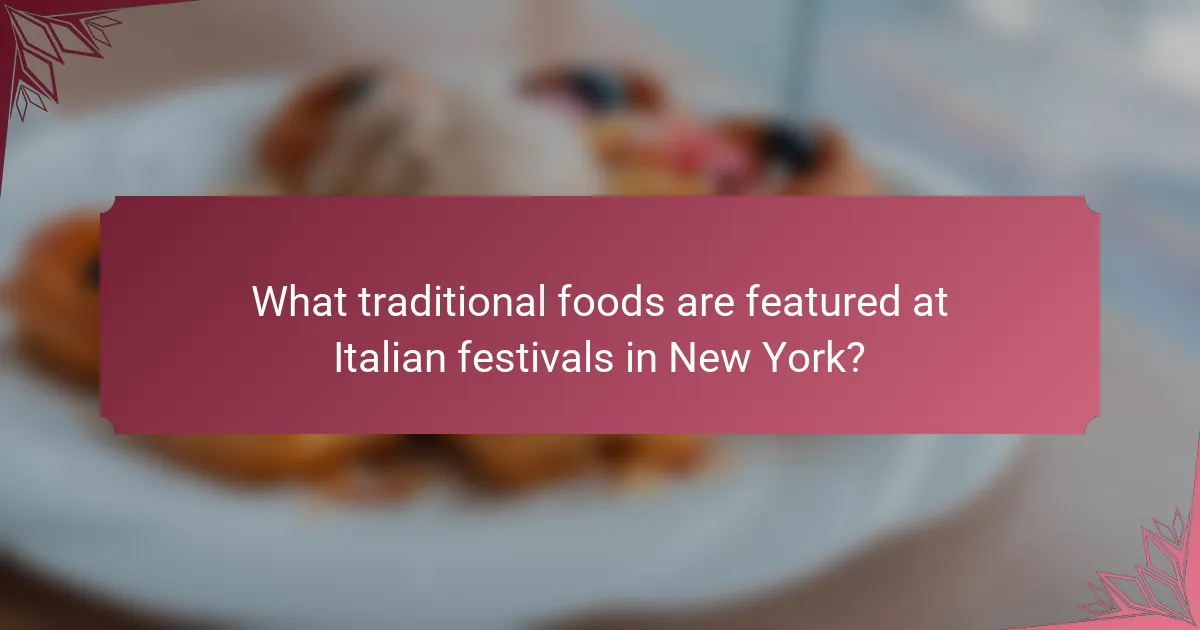
What traditional foods are featured at Italian festivals in New York?
Traditional foods featured at Italian festivals in New York include pasta, pizza, and cannoli. Festivals often showcase various pasta dishes such as spaghetti and lasagna. Pizza, especially Neapolitan-style, is a staple at these events. Cannoli, a popular dessert, is filled with sweet ricotta cheese. Other foods may include arancini, which are fried rice balls. Sausage and peppers are commonly served as well. These foods reflect the rich culinary heritage of Italy. They contribute to the festive atmosphere and cultural experience of the celebrations.
How do these foods represent Italian heritage?
Italian foods represent Italian heritage through their historical origins and regional diversity. Many traditional dishes reflect the agricultural practices and available ingredients of specific regions. For example, pasta originated in Southern Italy, showcasing the region’s wheat production.
Pizza, originating from Naples, symbolizes the working-class roots and communal dining culture. Dishes like risotto highlight Northern Italy’s rice cultivation and culinary techniques. Italian foods often incorporate family recipes passed down through generations, emphasizing the importance of family and tradition.
Additionally, festivals celebrating these foods reinforce community ties and cultural identity among Italian-Americans. Events like the Feast of San Gennaro in New York feature traditional foods, connecting attendees to their heritage. Thus, Italian foods serve as a tangible link to the cultural history and values of Italy.
What are the most common dishes served at these festivals?
Common dishes served at Italian festivals in New York include pasta, pizza, and cannoli. Pasta dishes often feature varieties like spaghetti and lasagna. Pizza is typically served in traditional styles, including Neapolitan and Sicilian. Cannoli, a popular dessert, consists of pastry shells filled with sweet ricotta cheese. Other dishes may include arancini, which are fried rice balls, and various antipasti platters. These foods reflect Italian culinary traditions and are integral to festival celebrations. Festivals celebrate Italian heritage through food, music, and community gatherings.
Are there any unique regional specialties showcased?
Yes, unique regional specialties are showcased at Italian festivals in New York. These festivals highlight dishes from various regions of Italy. For instance, Sicilian arancini, which are rice balls filled with meat or cheese, are a popular feature. Another example is Neapolitan pizza, known for its thin crust and fresh toppings. Festivals also present regional desserts like cannoli from Sicily and tiramisu from Veneto. Each dish reflects the culinary traditions of its region. This diversity enhances the cultural experience for attendees. It allows visitors to explore Italy’s rich gastronomic heritage in one location.
Why is food an essential part of Italian festivals?
Food is an essential part of Italian festivals because it embodies cultural heritage and community bonding. Festivals often feature traditional dishes that reflect regional flavors and family recipes. These foods are prepared and shared among attendees, fostering a sense of togetherness. Historical significance also plays a role, as many dishes are linked to specific celebrations or religious observances. For example, pasta is a staple at many festivals, symbolizing abundance and prosperity. Additionally, the act of preparing and enjoying food together strengthens familial and social ties. Festivals serve as a platform for showcasing culinary skills and preserving traditions. This emphasis on food highlights its importance in Italian culture and communal identity.
How does food enhance the overall festival experience?
Food enhances the overall festival experience by providing cultural connection and sensory pleasure. It allows attendees to engage with traditional recipes and flavors unique to Italian heritage. The act of sharing meals fosters community bonding among festival-goers. Additionally, food stalls and vendors create an inviting atmosphere that attracts more visitors. The variety of dishes available caters to diverse tastes, increasing overall satisfaction. Festivals with food offerings often report higher attendance rates. For example, the Feast of San Gennaro in New York showcases authentic Italian cuisine, drawing thousands each year. This connection to food enriches the cultural significance of the event.
What cultural significance do these dishes hold?
Italian dishes hold significant cultural value during festivals in New York. They serve as a connection to heritage for many Italian-Americans. Traditional foods reflect regional Italian customs and family recipes passed down through generations. Dishes like pasta, cannoli, and pizza symbolize community and shared experiences. Festivals often feature these foods, fostering a sense of belonging and pride. They also promote cultural education among diverse attendees. The consumption of these dishes reinforces cultural identity and continuity. Events celebrating these foods contribute to the preservation of Italian traditions in America.
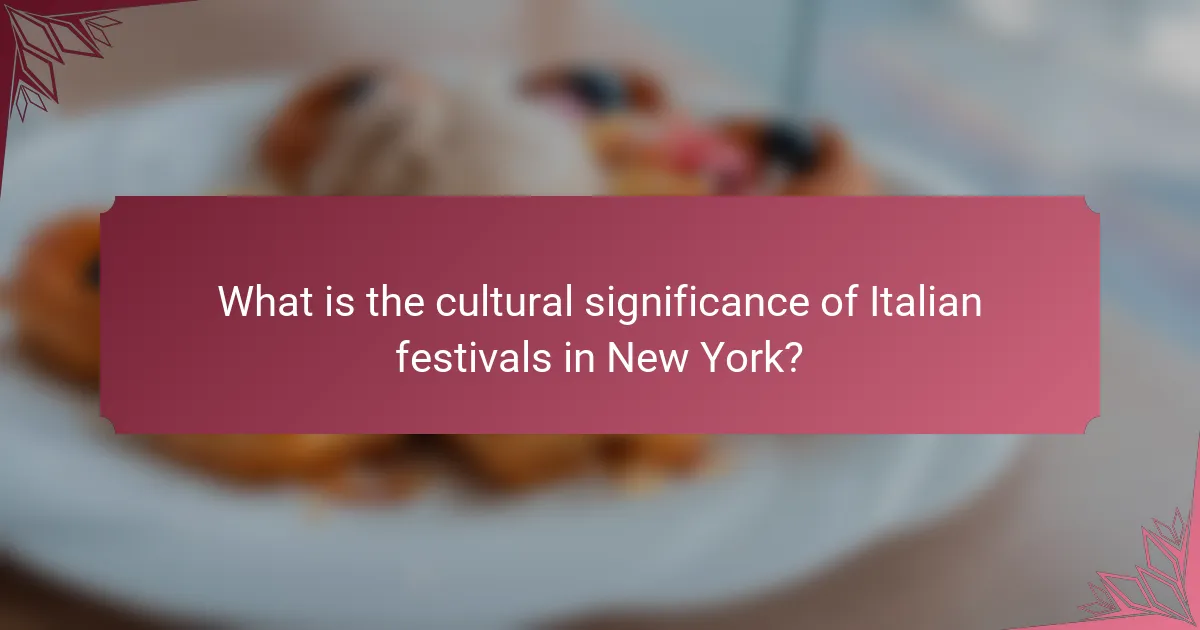
What is the cultural significance of Italian festivals in New York?
Italian festivals in New York hold significant cultural importance. They celebrate the rich heritage and traditions of the Italian-American community. These festivals foster a sense of identity and belonging among participants. Events like the Feast of San Gennaro attract thousands, showcasing Italian cuisine and customs. Such gatherings reinforce community bonds through shared experiences. They also promote cultural exchange, inviting diverse audiences to engage with Italian traditions. Historical roots trace back to early 20th-century immigrants, preserving their legacy. Overall, these festivals play a vital role in maintaining Italian cultural presence in New York.
How do these festivals promote cultural awareness?
Italian festivals in New York promote cultural awareness by showcasing Italian traditions and heritage. These events feature traditional music, dance, and art, allowing attendees to experience Italian culture firsthand. Food plays a significant role, with local vendors offering authentic Italian dishes. This culinary experience educates attendees about regional specialties and cooking techniques. Additionally, festivals often include workshops and demonstrations that explain cultural practices. Engaging activities encourage participation and deeper understanding of Italian customs. By bringing diverse communities together, these festivals foster dialogue and appreciation for cultural differences. Overall, they serve as a vibrant platform for cultural exchange and learning.
What educational activities are included in the festivals?
Educational activities included in the festivals often feature workshops and demonstrations. These activities provide insights into traditional Italian crafts and cooking techniques. Participants can learn to make pasta or create artisanal decorations. Additionally, cultural presentations may include storytelling and music sessions. These enhance understanding of Italian heritage and customs. Some festivals also host lectures on Italian history and art. This fosters a deeper appreciation for the culture. Overall, these educational activities enrich the festival experience for attendees.
How do festivals foster appreciation for Italian arts and music?
Festivals foster appreciation for Italian arts and music by providing immersive cultural experiences. They showcase traditional performances, allowing attendees to engage with various artistic expressions. Events feature live music, dance, and visual arts, highlighting Italy’s rich cultural heritage. Festivals often include workshops where participants can learn traditional crafts and music. This hands-on involvement deepens understanding and appreciation of Italian culture. Additionally, festivals promote community engagement and collaboration among artists and attendees. They create a platform for emerging artists to gain visibility and recognition. Historical festivals, like the Feast of San Gennaro, celebrate Italian traditions and attract diverse audiences. Such events reinforce the cultural significance and continuity of Italian arts and music in contemporary society.
What impact do Italian festivals have on the local community?
Italian festivals significantly enhance the local community by fostering cultural pride and unity. These events celebrate Italian heritage, bringing together residents and visitors alike. They promote local businesses through increased foot traffic and sales. Festivals often feature traditional foods, arts, and crafts, showcasing local talent. Community members participate in organizing and volunteering, strengthening social bonds. According to a study by the National Endowment for the Arts, cultural festivals contribute to community identity and cohesion. Additionally, these events can attract tourism, boosting the local economy. Overall, Italian festivals play a vital role in enriching community life and preserving cultural traditions.
How do they support local businesses and artisans?
Italian festivals in New York support local businesses and artisans by providing a platform for them to showcase their products. These events often feature stalls and booths where local artisans sell handmade goods. They also promote local restaurants and food vendors, highlighting traditional Italian cuisine. By attracting large crowds, festivals increase foot traffic to local shops. Additionally, they foster community engagement, creating networks among local entrepreneurs. Many festivals include workshops and demonstrations led by local artisans, enhancing visibility and appreciation for their crafts. Such initiatives contribute to the local economy and preserve cultural heritage.
What role do volunteers play in the success of these events?
Volunteers are essential to the success of Italian festivals in New York. They assist in various roles, including event planning, setup, and coordination. Volunteers help manage logistics, ensuring that activities run smoothly. They also engage with attendees, enhancing the overall experience. Their contributions promote community involvement and cultural exchange. Many festivals rely on volunteers for fundraising efforts and outreach. Studies show that events with active volunteer participation often see higher attendance and satisfaction rates. Their dedication fosters a sense of belonging and pride within the community.
What tips can attendees follow to fully enjoy Italian festivals in New York?
To fully enjoy Italian festivals in New York, attendees should plan their visit around the festival schedule. Research the specific events and activities available during the festival. Arriving early allows for a better experience and access to popular attractions. Sampling traditional foods is essential; dishes like cannoli and pasta are highlights. Engaging with local vendors enhances the experience and supports the community. Participating in cultural performances offers insight into Italian heritage. Attendees should also dress comfortably for walking and outdoor activities. Lastly, using public transportation can simplify travel to and from festival locations.
The primary entity of this article is Italian festivals celebrated in New York. Key festivals include the Feast of San Gennaro, Italian Heritage and Culture Month, and the Feast of Our Lady of Mount Carmel, each showcasing traditional foods, music, and cultural practices. The article explores how these festivals reflect Italian culture, their historical significance linked to immigration, and the role they play in community bonding and cultural preservation. Additionally, it highlights the impact of these events on local businesses and artisans, as well as tips for attendees to enhance their experience.
